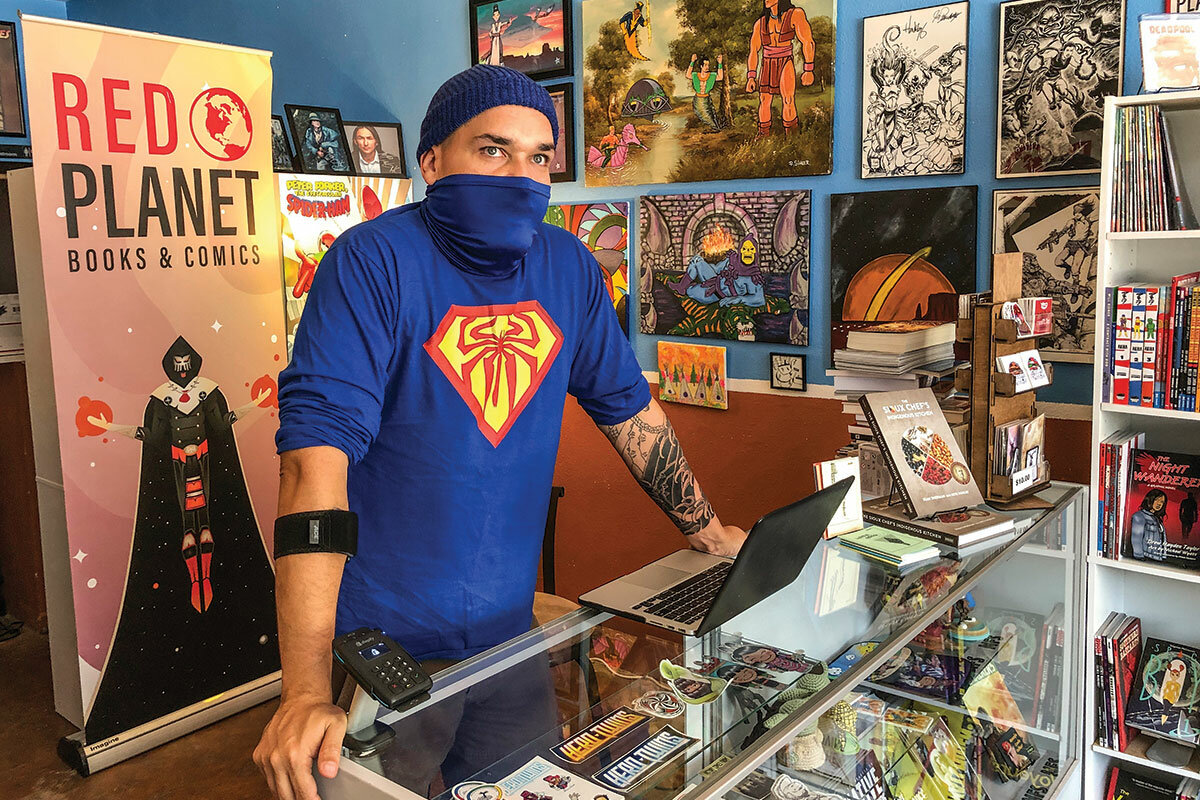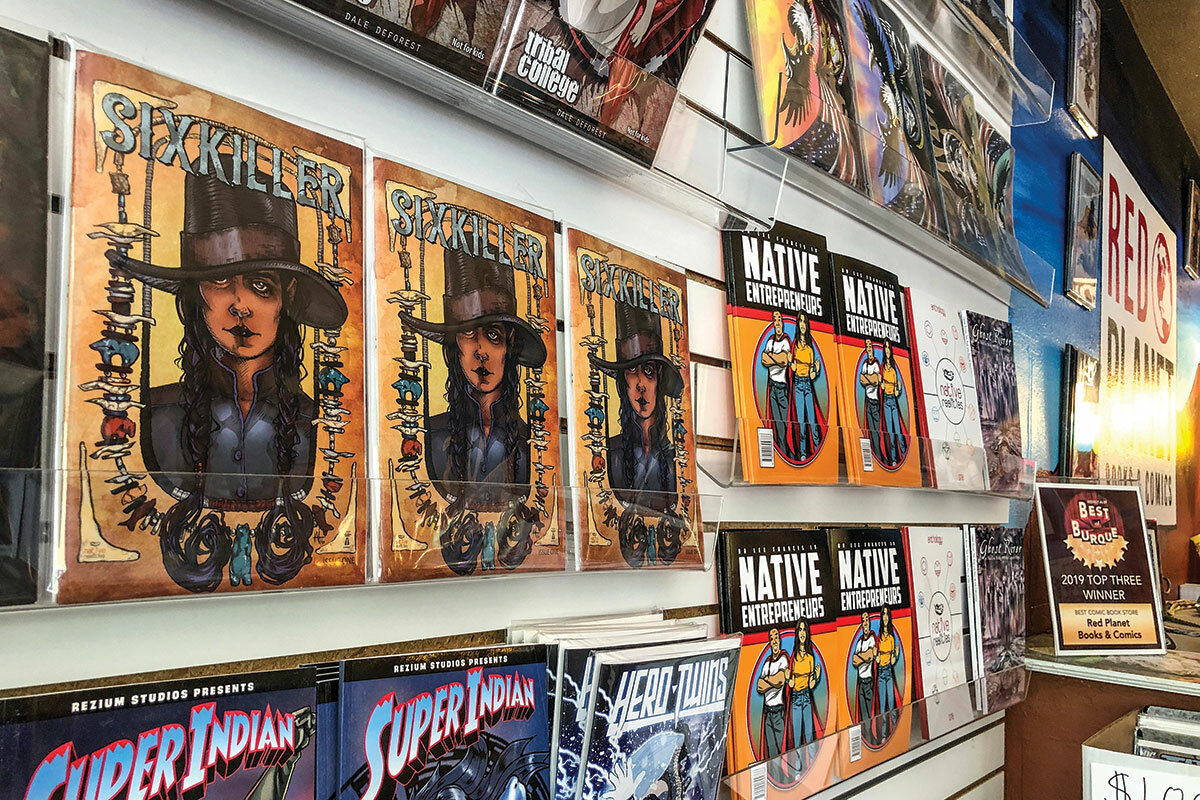Native American superhero comics leap stereotypes in a single bound
Loading...
Every superhero has an origin story. For Indigenous comic book store owner Lee Francis IV, the story begins at a drugstore in Albuquerque, New Mexico. He was just a Laguna Pueblo kid, looking through the racks of comic books, when he discovered the “Iron Man” series. He was hooked. “I just felt an affinity to the heroes in them,” Dr. Francis says today. “Their stories were woven into mythology. I could identify with that.”
Dr. Francis may have identified with the heroism, but he didn’t see himself in “Iron Man,” “Batman,” “X-Men,” or other popular comics. Native American heroes were practically nonexistent when he was growing up. If there was an Indigenous person, that character was minor, such as a sidekick, with all the attendant stereotypes (medicine men, warriors with feathers in their hair). The comic book industry offered no Indigenous comic books for a young Dr. Francis and his friends to revel over.
He has since done something about that.
Why We Wrote This
Indigenous comic books reflect the variety and vibrancy of Native peoples’ lives. Giving Indigenous heroes the starring role elevates Native perspectives and experiences.
In 2017, he and Aaron Cuffee III opened Red Planet Books & Comics in Albuquerque, which sells not only comic books but also graphic novels and children’s books that are written by, illustrated by, or that feature Native Americans. Dr. Francis says it’s the only Native comic book shop in the world and one of only a handful of Native American bookstores in the United States. He has plans to expand the shop.
“There are so many stories to tell,” he says in a telephone interview. “There’s always room for more!”
“We’re not a monolith”
Among the artists whose work appears at Red Planet is Jim Terry, a member of Wisconsin’s Ho-Chunk Nation. His illustrated memoir, “Come Home, Indio,” was a finalist for the 2021 Los Angeles Times Book Prize in the graphic novel/comics category and was chosen one of the Best Books of 2020 by Publishers Weekly. He is currently working on “West of Sundown” from Vault Comics.
“The question is, ‘Who is my audience?’” Mr. Terry says in an interview. “Am I talking to non-Natives about Native culture or am I writing for Natives? That is a beautiful tightrope to do both.”
Mr. Terry, an artist who lives in Chicago, occasionally goes into classrooms to teach art. The Native kids draw wolves howling at the moon. They draw eagles flying. They draw noble warriors, he says. “If that’s all that’s ever shown to them, that’s all they know. I tell them they can draw whatever they want.” It’s a revelation to them.
“We’re not a monolith,” says David Robertson, a prolific writer from Canada whose work is also featured at Red Planet. “There’s nothing that is specific to an ‘Indigenous story.’” Mr. Robertson also read comic books growing up, including “Spider-Man,” “Justice League,” and “Elfquest,” and imagined himself in those worlds even if Native Americans weren’t represented. A member of the Norway House Cree Nation, he’s won awards including the Writers’ Union of Canada Freedom to Read Award and the Aboriginal Circle of Educators award.
Mr. Robertson wants to create Native heroes that avoid stereotypes. “It’s an act of reclamation,” he says. Showing a Native hero can inspire young readers to think that they, too, have special powers. “I want them to define themselves,” he says.
Impacts on the culture
There’s an educational and outreach component to the work of Dr. Francis, the Red Planet owner, who has a Ph.D. in education. He founded Native Realities Press in 2015, which publishes books, anthologies, and games with Native perspectives. He is also executive director of Wordcraft Circle of Native Writers and Storytellers, a mentoring organization. For his fellow “Indiginerds” he created Indigenous Comic Con, now called IndigiPop X. The impresario is already planning the 2023 iteration, which is coming, he hopes, in the spring.
Red Planet is making an impact, not only for Indigenous artists and writers by supporting and selling their work, but also for readers as well.
The shop carries titles that appeal to a broad range of people and interests, including “Fry Bread: A Native American Family Story,” a children’s picture book; “Love After the End: An Anthology of Two-Spirit and Indigiqueer Speculative Fiction,” an LGBTQ story collection; “Healer of the Water Monster,” a novel for middle-grade readers; and “7 Generations: A Plains Cree Saga,” an epic graphic novel.
“It’s a joy to see Native folks come into the shop and be amazed at what we’re doing. To know how amazing it is to be able to tell our own stories,” Dr. Francis says.
Centuries of propaganda
Recognition has been a long time coming, say Indigenous artists. The comics industry has hundreds of years of anti-Native American propaganda to overcome, and it has been slow to act, although there have been attempts over the decades.
DC Comics had characters like Ohiyesa “Pow Wow” Smith, a sheriff with Sioux heritage, in “Western Comics” of the 1950s. Marvel’s first Native American superhero was Red Wolf, who appeared in 1970. Red Wolf had mystical powers and a trusted wolf companion named Lobo.
Comic books created by Native people, or at least created in consultation with tribes, included “Tribal Force.” First published in 1996, it was created by writer Jon Proudstar, whose heritage includes Yaqui and Mayan ancestors, and artist Ryan Huna Smith, who has Chemehuevi and Navajo roots. “Peace Party,” published in 1999, told the story of two Hopi Pueblo cousins and their adventures.
Comic book artists, according to a recent survey by Zippia, are 73% white. Only 1.1% are Native. With graphic novels and comics selling upwards of $1.2 billion a year in North America, there’s room for improvement in Native representation in the industry.
It’s coming, say Dr. Francis and the artists interviewed. Comics insiders are seeing an explosion of interest in Native stories, particularly with the recent successes of TV series like “Rutherford Falls” and Taika Waititi’s and Sterlin Harjo’s “Reservation Dogs.” (Mr. Waititi also returns to the Marvel universe this month, as the director of “Thor: Love and Thunder.”)
“I am encouraged,” Mr. Terry says. “There’s a renaissance happening. Everyone is free to tell their story.”
Dr. Francis says, “I want to make the planet a better place. Just like superheroes do.”







